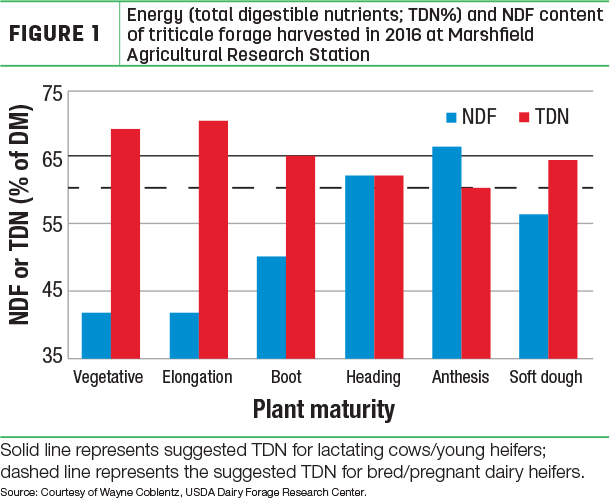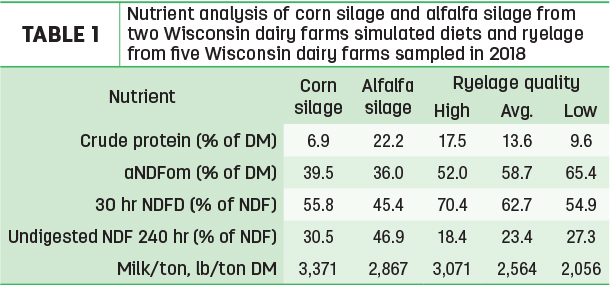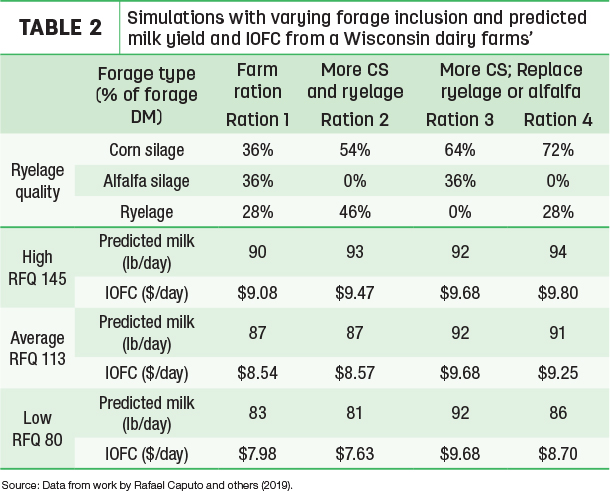In recent years, there has been an increased interest to harvest cover crop cereal grain forages such as rye or triticale in spring to help supplement inventories.
The use of cereal grain forages as cover crops can reduce soil and nutrient losses in addition to the forage harvested. Work with cereal grain forages has shown there is a balance between quality and yield that should be considered.
In a recent Wisconsin study in Brown and Dane counties, cereal grain forage quality was key to potential inclusion in lactating cow diets and to maintain milk production. Dairy producers should evaluate their early spring forage inventories to determine what quality forage they need for feeding their herds before making harvest plans.
Harvest timing is important to obtain the desired balance of dry matter (DM) yield and quality. Data from the University of Wisconsin Marshfield Agricultural Research Station (Figure 1) shows that maturity affects both the yield and quality of fall-planted, spring-harvested winter triticale forage.

At boot stage, yields can range from 1 to 2 tons DM per acre with increasing yields thereafter – up to three to four times that yield by soft-dough stage.
Similar to other forages, fiber concentrations (NDF) increase, but other important quality measures (protein and digestibility) decline concurrently as the plant matures from a vegetative to reproductive stage. For high-quality forage to feed lactating cows, you need to target the boot stage (just prior to the seedhead emerging from the flag leaf) to balance yield and quality. If producers need moderate-quality forage for bred/pregnant heifers, target between the boot to soft dough (heading to anthesis stage is ideal) in order to best match requirements with forage quality (Table 1).
 Subsequent crop decisions will be dictated by the timing of harvest with harvesting at a higher quality in mid- to late May, allowing for more flexibility in planning the subsequent crop, but with significantly reduced yield (one-half to three-quarters reduction at boot stage compared to anthesis/soft-dough).
Subsequent crop decisions will be dictated by the timing of harvest with harvesting at a higher quality in mid- to late May, allowing for more flexibility in planning the subsequent crop, but with significantly reduced yield (one-half to three-quarters reduction at boot stage compared to anthesis/soft-dough).
However, if a later harvest date into early to mid-June is chosen to increase yield, then later forage planting options may be a shorter-day corn silage, other warm-season annuals (forage sorghum, sorghum-sudangrass, teff grass) or a perennial forage establishment possibly, depending on soil moisture.
Use of cereal grain forages in lactating cow diets is highly dependent on forage quality and was recently evaluated. Based on forage quality analysis of cereal rye silage gathered from five dairy farms in Brown and Dane counties, lactating cow diets from two of the farms were simulated with different qualities (low, average or high) of the ryelage replacing corn silage or alfalfa silage. Milk production and income over feed costs (IOFC) were estimated.
Calculated cost of production of the forages were $70 per ton DM for corn silage (8.8 tons DM per acre), $105 per ton DM for alfalfa silage (5 tons DM per acre) and $128 per ton DM for ryelage (2 tons DM per acre), but highly depends on forage yields.
The original inclusion rate of ryelage in the rations were 8% to 17% of the ration DM or 21% to 28% of the forage. Forage quality of the ryelage samples had significant variation (Table 2); notably, aNDFom (ash-free NDF) ranged from 52% to 65% of DM, crude protein from 9.6% to 17.5% of DM and 30-hour NDF digestibility from 55% to 70% of NDF.

NDF content and digestibility is a main factor of including these forages in lactating cow diets with these forages having high NDF digestibility at the boot stage. When high-quality ryelage was increased in the diet by replacing alfalfa, milk production and IOFC was similar to the farms’ original diets. When corn silage was increased as a portion of the forage (either replacing alfalfa or ryelage), the milk production and estimated IOFC increased due to its higher energy content and lower cost of production. However, when average or low-quality ryelage was added to the simulations, estimated milk production and IOFC was decreased due to the lower-energy forage.
Producers planning to harvest high-quality cereal grain forage for lactating cows this upcoming spring need to be watching the crop closely, as maturity can quickly advance from boot to heading stage, and weather will play a major factor in the decision to harvest. If harvest is delayed, this forage is ideal for feeding breeding-age to pregnant heifers, with it possibly making up a majority of the diet.
Cereal grain forages provide an opportunity for double cropping with a summer crop. Not only can these forage options provide needed forage, but they can help use manure nutrients in fall manure applications and allow for manure application in early summer, which may be important for operations limited in manure storage and available land. Harvest maturity is the most important factor determining the quality of the forage, and planning harvest operations will help meet quality needs.
References omitted but are available upon request. Click here to email an editor.






